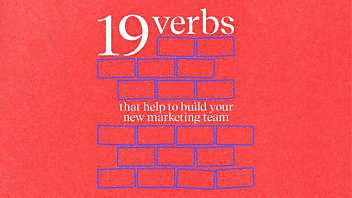“If we’re going to take advantage of this lead nurturing thing, we probably need to look at our marketing team. Any thoughts on the right the shape, structure and reporting lines we should implement? What’s best practice? Do you have any job descriptions?”
This was an email from a client last week. It followed on from a similar one from another CMO a couple of weeks previously. I thought I should probably know the answer to these questions, but found I didn’t. As you do, I went to Google and did some research and the usual suspects popped up.
- The Content Marketing Insitute has written a good job description for a content marketing officer and Joe Pulizzi has done a great post on the key roles in the new content marketing department.
- Hubspot has provided a bunch of great resources on how to recruit an all star marketing team
- Econsultancy produced a report on content marketing which has some great stuff on tasks and goals.
But as I was going through this great material, it seemed to me that being good at content marketing and lead nurturing is probably more about culture and approach than about structure. So here are a lot of verbs that seem important to me when you’re thinking about building your new marketing team. As I dimly remember from my English grammar lessons at school, verbs are ‘doing’ words. And the ones below summarise what I think the modern B2B marketing department should be doing.
Lead, control, manage and sell – Someone obviously needs to be in charge. That person needs to be the steward of overall company positioning and messages (including willingness to adapt as market or competitive conditions change). She also should define what content is to be produced (including why we’re publishing it) and set the direction for which media – e-books, video, podcast, white paper, viral – should be used and in what combination and what the schedule is. Probably this person will have a major say in the channel mix. In the bad old days, the more senior a marketer became, the more distant they got from the point of marketing engagement. In our new ultra changeable, multi-coloured digital world, it feels as if whomever you choose for this role needs to be really comfortable at that point of engagement – regardless of channel, media or content type. And they need to be numerate, someone who believes in the power of data. Someone who wants to sell the impact of marketing to the Board and get more budget.
Research, create, edit, curate and publish – There’s probably at least two or three jobs inside these five verbs. The ability to create insanely good content that’s entertaining, informational and enlightening feels as if it lies at the heart of content marketing. Finding out what your readers actually care about comes from solid research, both online and face-to-face (As an aside. I’m always amazed how little time most marketers spend talking to actual customers, finding out what their challenges are, how they describe those issues and what they think of the company’s products.) Usually the people who are your best content creators are your best researchers too.
It may be that your best writers don’t have to be working inside the marketing department – they can work at agencies (we know a good one if you’re interested) or perhaps in your product marketing department – but smebody inside marketing needs to be able to build the editorial calendar and establish quality standards for content and recognise when those standards aren’t being met. The bar for quality content is higher than its ever been – because the struggle for attention online is so fierce and intense. I believe that if you have a company blog (if you don’t, stop reading this and start one), that should be written by someone in house. That someone needs to spend time with all the fun people in the company – the salesforce, the techies, the support folks – to winkle out those special stries that will keep visitors coming back for more. It’s hard for an outside ghostwriter to do that as effectively as an in house person.
Content curation isn’t just about finding content that supports your case and pressing ‘share’; it’s not a synonym for aggregation. It’s (and here are a few more important verbs) about identifying, sorting, culling, vetting, contextualizing and then choosing which links to display. In the art gallery or museum world, the curation process is usually based on a desire to shed new light on an established topic or get an audience to understand something in a different, novel way. It’s certainly about attracting new and larger audiences for sometimes obscure artifacts, or exhibitions. Those also feel like noble goals for content curation online too. People who do it well have expertise in their subject area. Finding a good one can make a content marketing programme rock.
Publishing is also not just a mechanical task. I’m talking about knowing how to schedule, merchandise and cross-promote content. And how to recycle older stuff and keep it fresh. This requires planning and it requires familiarity with (and interest in) the content itself. It requires knowledge of when to retire content when its out of date or no longer fits with the company’s positioning or strategy. Good publishers – just as in the traditional media world – shape the vision of the content because they understand the audience they’re trying to reach.They don’t have to be senior people because in B2B we’re not usually talking about ad strategies, whereas in traditional media they tend to be the most important people in the room. But they have to be engaged in the process. We regularly have to fight battles with our clients to stop them publishing something just because they happen to have produced it and it’s next on someone’s list. The publishing job online has a quality control component too and as such requires taste and expertise.
Own – This feels like a key one to me. In the bad old days of interruption-based, broadcast marketing, marketers essentially rented other people’s database assets. They did it when they went to an industry show, purchased a DM list or advertised in a trade magazine. They exchanged money, usually for one-time access to lists somebody else had painstakingly (or in some of the shows I’ve been to, lists I’ve hired or magazines I’ve used not so painstakingly) built. Now, the best content marketing is designed to build a company’s own list. You only build a great list if you’re doing the verbs in the previous few paragraphs, but to keep that list fresh and usable and useful, you need someone to manage it.
Listen, engage, build – This role (or roles) covers distributing a company’s content across the Web, community building and nurturing prospects, partners and customers (via social media, SEO and the like). This job has a key listening element – responding to (and making) comments, gauging the temperature of debate, forging partnerships online. This feels like it should be a role for someone who is close to sales every day and who can get under the skin of the business and write the short form material that keeps Google happy and prospects coming back, who can take responsibility for Twitter, Facebook, LinkedIn and the like and identify and extract the expertise that’s inside colleagues’ minds and desktops and reshape it into social content: tweets, slideshows, ebooks, videos, images, blogs. This person should ultimately be THE social evangelist for the company responsible for educating, enabling and energizing the company around the changing landscape of social technologies and what it could mean for the future of the company. The person that does this job should have a written ‘voice’, proven knowledge and experience of the social web (a personal blog or experience with a company blog should probably be a pre-requisite), able to work with agencies and have the drive to uncover fresh content opportunities.
Experiment, hypothesise, learn – we find ourselves in a new world where more often than not we don’t have all the answers. The great news: the explosion in marketing data created by the web and marketing automation platforms means that we can experiment to our heart’s content to find out what really does work. Somebody in the team should be working in a lab-like environment, probably surrounded by clouds of B2B white, swirling smoke and mirrors testing out hypotheses and trying to turn those hypotheses into universal marketing theories. It’s early days for marketing automation in B2B, so a ‘test & learn’ culture is pretty much essential.
Integrate, optimise – Gartner says that the CMO will be spending more on IT than the CIO by 2017. I’ve written recently about the emergence of marketing operations in B2B companies and it’s clear that a suite of marketing applications is emerging – CRM, CMS, marketing automation, business intelligence and analytics, email platforms, social media technologies, behavioural marketing and so on – that’s growing in number and complexity by the day. Somebody needs to work out how marketers are going to use this stuff efficiently and effectively. This feels like a crtical role (maybe even group of roles) for the modern B2B marketing team.
Measure – B2B marketing needs to measure everything that moves – and quite a few that don’t to find out why. I’m not sure enough B2B marketing teams have cottoned on to the fact that there’s gold in them thar data hills. Analytics makes your marketing better, and allows you to improve it in real time and forever. It provides the defence against the naysayers.
So, there you go. 19 verbs that should help you build the modern B2B marketing team. Have I missed any out?

Enjoyed this article?
Take part in the discussion








Comments
There are no comments yet for this post. Why not be the first?